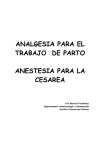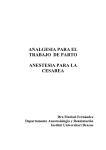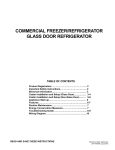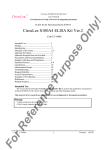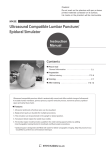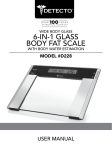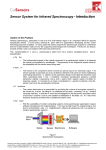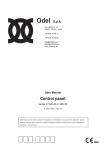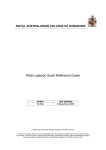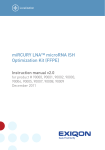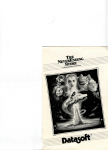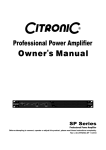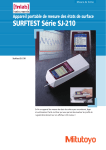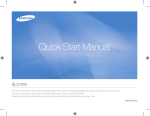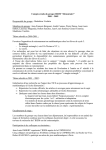Download User Manual - Kyoto Kagaku America Inc.
Transcript
"Caution: Ink from this manual can stain the Lumbar Puncture Model - do not let it touch the model." ※このマニュアルがモデルの皮膚に直接触れないように御注意ください。色移りすることがあります。 M43B Lumbar Puncture Simulator Ⅱ M43B 腰椎硬膜外穿刺シミュレータ ルンバールくん II Instruction Manual 取扱説明書 1 English 3-21 日本語 23-43 2 Welcome Today, medical professionals have ready access to advanced imaging technologies such as CT, MRI and ultrasound scans that clearly enhance the quality of medical care. However, despite its use for more than 100 years, the lumbar puncture remains indispensable for the rapid diagnosis of meningitis, encephalitis or fever of unknown origin. The lumbar puncture also remains important for the diagnosis and treatment of numerous conditions seen by emergency care, primary care, neurology, oncology and anesthesia services. Thus, even today, medical competency requires skillful performance of this procedure. In the past, medical students could practice lumbar punctures on live patients in order to develop the requisite technical skills. However, for good reasons, this is no longer the case. Although medical schools and residency training programs recognize the need for formal procedural skills training, there are limited opportunities for such programs to teach and assess procedural competency. This unfortunate situation has now changed. Keio University Medical School, in partnership with Kyoto Kagaku, has created a realistic lumbar puncture simulator that allows students and medical professionals to practice frequently and achieve high levels of procedural competence without placing any patients at risk of harm. By all means, please try this innovative lumbar puncture simulator. Through practice on this special equipment, students at all levels of training can increase their procedural comport, competence and efficiency. We wish you, and your patients, well. Takahiro Amano, MD Professor and Head, Medical Education Center Gregory A. Plotnikoff, MD, MTS Associate Professor Keio University Medical School Before You Begin This lumbar puncture simulator has been developed for the training of medical professionals only. Any other use, or any use not in accordance with the enclosed instructions, is strictly prohibited. The manufacturer cannot be held responsible for any accident or damage resulting from such use. Please use this model carefully and refrain from subjecting in to any unnecessary stress or wear. Should you have any questions on this simulator, please feel free to contact our distributor in your area or KYOTOKAGAKU at any time. (Our contact address is on the next page) ○ The contents of the instruction manual are subject to change without prior notice. ○ No part of this instruction manual may be reproduced or transmitted in any form without permission from the manufacturer. Please contact manufacturer for extra copies of this manual which may contain important updates and revisions. ○ Please contact manufacturer with any discrepancies, typos, or mistakes in this manual or product feedback. Your cooperation is greatly appreciated. 3 Table of Contents Welcome...................................................................................... P3 Before You Begin................................................................ P3 Table of Contents............................................................... P4 Consumables............................................................................ P4 Set Includes................................................................................ P5 Before training.......................................................................... P6-10 (CSF pads)................................................................................ P7-9 (Epidural Pad)....................................................................... P10 While Your Training Session.......................................... P6-10 After Training........................................................................... P12-13 FAQs, DOs and DON'Ts................................................... P14 Lumbar Puncture-Five Steps for proficiency....P15-21 Consumables Product Code 11348-090 11348-110 11348-120 11348-130 11348-140 11348-150 Mark N O S SO EP Part Name Norml CSF Puncture Block Normal Obesity CSF Puncture Block Senior CSF Puncture Block Senior Obesity CSF Puncture Block Epidural Puncture Block Skin Cover For inquiries and service, please contact your distributor or: http://www.kyotokagaku.com [email protected] Main Office and Factory 15 Kitanekoya-cho Fushimi-ku Kyoto 612-8388, Japan Telephone : 81-75-605-2510 Facsimile : 81-75-605-2519 LA Office ( for USA , CANADA and Mexico customers ) 3109Lomita Boulevard, Torrance, CA 90505 ,USA Telephone : 1-310-325-8860 Facsimile : 1-310-325-8867 4 Set Includes a. Lumbar Region Model・・・・ 1 b, CSF Puncture Blocks(4variation 5 pieces) b-1 Normal CSF・・・ ・2 b-2 Obesity CSF・・ ・ 1 b-3 Senior CSF・・・ ・ 1 b-4 Senior Obesity OSF・1 c, Epidural Puncture Block ・・・・ 1 d, Lumbar Spine Model ・・・・・・ 1 e, Skin Cover ・・・・・・・・・・・・ 1 f, Syringe ・・・・ ・・・・・・・・・・ 1 g, Stand・・・・・ ・・・・・・・・・ h, Irrigator bag 1 ・・・・・・・・・・ 1 i, Support Base (Lateral Position)・ ・ 1 j, Support Base (Sitting Position)・ ・ 1 k, Support Base (Team Teaching)・・ 1 l, Carrying Case(No Picture)・ ・・ ・ ・1 5 Before Training Irrigator bag Stand Skin Cover Clamp Supporting Base Setting with a CSF block ・Assembly the stand. ・Hang the irrigator bag to the stand. 6 Before Training:CSF Puncture Block ・Block type and the direction are indicated on the side wall of each block. N : O: NS: OS: EP: N Connector to the Syringe Normal CSF Obesity CSF Senior CSF Senior Obesity CSF Epidural Connector to the irrigator bag Obesity block This side comes at the head-end of the Lumbar Region Model. Senior block ※ Obesity type has a lumbar spine in deeper position. Senior type has different tissue resistance and bone shape. ・Connect the tip of the tube from the irrigator bag to the tube at the head-end of the puncture block. Insert the tube deeply so that it won't come off during the session. ・Fill the irrigator bag with water until the surface reaches to the 200ml line. 200ml 7 Before Training:CSF Puncture Block ・Connect the syringe to the plug at the end opposite to that of the tube from the irrigator bag. Insert, turn clockwise and lock the syringe in place. ・With the clamp opened, aspirate a small amount of water into the syringe. Should any air bubbles remain in the system, tilt the system and aspirate fluid with the syringe until only water remains in the tubing. ・When the block has filled with water, detach the syringe from the connector by turning the syringe counter-clockwise. Then press close the tube clamp. ※ Keep the clamp closed while the session is not in action. ・Insert the block into the Lumbar Region Model. 8 Before Training ・Noting the marks at the back of the skin cover(L,R, ↑), attach it to the Lumbar Region Model. ・Put the Lumbar Region Model on a supporter base. Front Head ※ The simulator is designed to show an appropriate CSF pressure when it used in lateral position and Back 200cc water in the irrigator bag. Adjust the pressure to fit your training purpose when you use the system in sitting position. ・The sitting position supporter base is designed to Front Back come to the front end of the Lumbar Region Model. ・Open the clamp and start the training session. 9 Before Training: Epidural Block Irrigator Bag Stand Clamp Skin Cover Drain Pouch Setting with Epidural Block. ・Empty the drain pouch completely. ・Connect the tube tip from the drain pouch, to the side connector tube ・Following the steps of CSF block preparation, fill the block with water, set it to the Lumbar Region Model and cover with the skin cover. 10 While your training session For details, please refer "Lumbar Puncture: Five Steps for Proficiency", P15-21 on this manual. ・Landmarks can be palpated. <CSF collection> ・When the needle tip reaches in the subarachnoild space, water (simulated CSF) can be collected. ※ The simulator is designed to show an appropriate CSF pressure when it used in lateral position and 200ml water in the irrigator bag. Adjust the pressure to fit your training purpose when you use the system in sitting position. <Epidural Puncture> ・Make sure that the needle is not in the subarachnoid space (no water flows out), and then inject water (simulated saline) or air into the epidural space. ・Successful performance can be confirmed by observing the injected air/water fills the drain pouch. ※ Empty the drain pouch after each trial. ※ When the puncture pad gets worn, water/air may be able to be injected even if the needle tip has not reached the epidural space. When this occurs, change the puncture site or replace the pad by a new one. 11 After Training ・Remove the model skin cove and remove the puncture block from the Lumber region model, holding it with its hard part. ・ ・Pull back the syringe's piston to at least the 50 ml mark. Lock the syringe onto the connector on the block by turning clockwise. ・Release the clamp. ・Slowly depress the piston and push air into the water-filled block until all the air has been injected. 12 After Training ・Close the clamp ・Turn the syringe counter-clockwise to remove it from the block. Disconnect the reservoir tube from the block. ・Disconnect the drain pouch from the epidural block and empty the pouch. ・If you continue the session, return to P6 and set a new block. ・ When you finish the session for the day, empty the irrigator bag and dry all used components naturally and store them in room temperature, avoiding direct sunlight or exposure to elements. 13 FAQ s Q, Water does not come out even if the needle tip is surely in the subarachnoid space. A, Is the clamp released? Isn't the tube folded? A, Is the water surface in the irrigator bag at 200ml or above? A, 21G is the recommended needle size for CSF collection training with the simulator. If you still experience the difficultis, try with a larger needle. A, Isn't your needle clogged? Use a needle as new as possible. A, The fluid comes slowly, drop by drop. Wait and see for 2-3 seconds. Q, The soft tissue part of the puncture block is coming off when I grab the block. A, The soft tissue and bone part of the puncture blocks are not adhered. The soft part may look like coming off when you grab it strongly, this is not faulty. However, to keep the blocks longer, we recommend holding the hard part when you handle them. Q, (Epidural puncture pad) Water/air can be able to be injected even if the needle tip has not reached the epidural space. A, the puncture block is worn. When this occurs, change the puncture site or replace the pad by a new one. DOs and DON'Ts DOs Handle the manikin and components with care. Talcum powder may be used on the manikin after use to preserve suppleness of the skin and prevent oils from staining the surface. Store the manikin in its storage case when not in use. Storage in a dark, cool area will keep the manikin skin from fading. The manikin skin may be cleaned with a wet cloth and mildly soapy water or diluted detergent. DON'Ts Please do not let ink from pens, newspapers, these instructions or other sources come in contact with the manikin, as they cannot be cleaned off the manikin skin. Never use ethanol or organic solvent like paint thinner to clean the skin, as this will cause deterioration of the skin. 14 Lumbar Punc ture: Five Steps for Proficiency CORTIC AL V E INS S UPERIOR SAGCTAL SINUS CORPUS C ALLOSUM DUR A MAT E R SUB ARACHNOID SPACE ARACHNOD GRANULATIONS CEREBRAL HEMISPHERE THIRD VENTRICLE PONS CEREBELLUM FOURTH VENTRICLE ME DULLA MEDIAN APERT URE SPINAL CORD CAUDA EGUINA Here, a spinal tap c an be done without damage. Diagram of spinal fluid c irc ulation Background: Cerebros pinal fluid (CSF ) is a clear s aline solution produced primarily in the choroid plexus in both lateral ventricles . T he rate of production is approximately 20ml per hour or 500 ml per day. T he CSF is found in the s ubarachnoid s pace (between the arachnoid and pia mater layers of the meninges ) with a total volume of les s than one-third that of the daily production. Thus unimpaired fluid circulation is very important in health and disease. T he CSF fluid circulates from the lateral ventricles through the interventricular foramina (foramina of Monro) into the third ventricle. F rom there it pas s es through the s mall cerebral aqueduct in the brains tem into the fourth ventricle. T he CSF then pas s es through three s mall foramina (central foramen of Magendie, which is als o known as the median aperture, and the two lateral foramina of Luschka) into either the central canal of the s pinal cord or into the cis terns of the s ubarachnoid s pace. The CSF both bathes and cushions the brain and spinal cord. Its circulation includes flow dis tally to the lumbar cis tern which enclos es the cauda equina (where the lumbar puncture is performed) and then s uperiorly to the cerebral sagittal sinus where it is reabs orbed via the arachnoid granulations (the smaller villi and the larger P acchioni's bodies ) into the venous sys tem. Impaired CSF flow through the small foramina is associated with increased pressure in the lateral ventricles (hydrocephalus) or with dis rupted intracranial blood flow. 15 Step 1: Unders tand the lumbar puncture's indications , contraindications , and spinal fluid examination T he s pinal fluid needs to be examined in cas es of s us pected meningitis , fever of unknown origin, central nervous s ys tem leukemia or lymphoma and for the evaluation of many neurologic dis eas es including multiple s cleros is and recurrent s eizures . Oncologis ts frequently us e a lumbar puncture to adminis ter chemotherapy to the central nervous s ys tem. Anes thes iologis ts us e a lumbar puncture to adminis ter s pinal anes thes ia for s ome types of s urgery. B y lumbar puncture, amphotericin B can be infus ed for treatment of fungal meningitis . Lumbar punctures are contraindicated in the pres ence of in the pres ence of an injection at the lumbar puncture s ite, papilledema, s evere thrombocytopenia or uncorrected bleeding dis orders . Additionally, lumbar punctures are contraindicated in the pres ence of cerebral mas s les ions s uch as large abs ces s es , tumors and intra cranial hemorrhage. S ubdural hematomas may als o increas e the ris k of herniation. F or this reas on, cerebral C T s cans may be performed prior to lumbar puncture. Increas ed intracranial pres s ure can be s een in trauma or infection. Decreas ed intracranial pres s ure can be s een with obs tructed flow s uch as due to a s pinal cord tumor. C loudy fluid is as s ociated with the pres ence of white blood cells , increas ed protein or the pres ence of microorganis ms . B loody or reddis h fluid is as s ociated with s ubarachnoid hemorrhage or traumatic puncture. B rown, orange or yellow fluid is as s ociated with elevated protein or old blood in the C S F . Increas ed protein is s een with blood in the C S F , polyneuritis , tumors , trauma, diabetes , infection and inflammation. Decreas ed protein is s een with rapid C S F production. Increas ed glucos e is s een with hyperglycemia. Decreas ed glucos e is s een with hypoglycemia, bacterial or fungal infection, tuberculos is or carcinomatous meningitis . S ometimes gamma globulin levels are measured. T hese are increased with demyelinating diseases such as multiple sclerosis or G uillain B arre syndrome. 16 Step 2: Locate the puncture site and position the patient The spinal cord as a s ingle trunk ends at the dis tal end of L1. For this reas on, the lumbar puncture is performed preferentially in the interspaces between the posterior elements of L4 and L5. Alternately, the space between L3 and L4 can be used when the L4 L5 interspace is not available. In adults , no puncture is ever done between L1 L2. In small children, the medulla oblongata ends more proximally and thus , if necessary, the L1 L2 space can be used. The superior, posterior iliac crest is located at the level of L4 L5. T he imaginary transverse line that connects the crests is termed J acoby’s line. To identify the L4 L5 vertebrae, place the palms of your hands over the posterior iliac cres t so that the superior edge is under your second (pointer) finger. Y our thumbs will connect at, or point to, the location of the L4 L5 vertebrae. The lumbar punc ture c an be performed in two positions . The mos t common, the lateral recumbent position, is performed with the patient on his or her side with their head propped up on a pillow. The knees and torso a re flexed to optimiz e the inter laminar foramen of the vertebrae. Ask or assis t the patient to draw their legs up to their chest. Make certain that the craniospinal and transverse planes remain stable. Pleas e note that excessive flexion can compromise the upper airway. In patients with pulmona ry disorders or with potentia l a irwa y compromise in the la tera l recumbent position, the s itting position can be used. Seat the patient on the edge of the examination table. F lex the trunk by having the patient lean forward and res t their elbows on their knees . T he disadvantage of this pos ition is that CSF pressure cannot be measured. In either position, the craniospinal and transverse planes mus t remain s ta ble. F or this reason, assis tance with restraining/s tabilizing the patient is crucial. 17 Locations of spinal and medullar struc tures L 4-L 5 How to find L 4& L 5 Use both hands to hold just below the knees. B end the knees. P unc ture area Curl the body forward Curl the body forward Lateral recumbent position Step 3: P rac tic e the lumbar punc ture tec hnique on the simulator T his lumbar puncture s imulator provides additional equipment to emphas ize the importance of s pinal flexion as well as lumbar region s tabilization. T he importance of s pinal flexion is readily s een with the model of the lumbar s pine that is provided for teaching (c). As the s pine flexes forward, note that the inferior articular proces s es of the upper vertebrae move upwards . Als o note the corres ponding remarkable increas e in the inter laminar s pace between the inferior notch of the s uperior lamina and the s uperior notch of the inferior lamina. T his inter laminar s pace is the route of the needle ins ertion into the s ubarachnoid or intradural s pace. T his importance of lumbar region s tabilization is taught us ing different bas es for the lumbar region model. T he larger bas e (j) puts the model in the correct recumbent pos ition. When the model (a) is attached to this bas e (j), s tudents can practice technique by thems elves as illus trated below. T his does not approximate clinical reality, however. Erec t s pine T he s maller bas e (k) requires s tudents to practice as a team for correct pos itioning and s tabilizing of the model. T he s maller bas e s imulates the ins tability of a living patient. Us e of this bas e allows the as s is tant to practice keeping the cranios pinal and trans vers e planes s table and the s pine flexed. T his teamwork which does approximate clinical reality is illus trated below. T o conduct actual lumbar practice, as s emble the model as noted above. T o approximate normal C S F pres s ure of 150 -180 mm Hg, fill the res ervoir pouch to 14- 18 cm in height. Spine bending forward After locating L4 L5, place the needle perpendicular to the vertical plane. W ith the bevel pointed toward the ceiling (parallel to the direction of the ligamentum flavum) and the s tylet in place, s upport the needle between you index fingers and s tabilize the hub of the needle with your thumbs . Advance s lowly through the s kin in the direction of the umbilicus . T eam s upport prac tic e As the needle enters deeper s tructures , there will be a change of res is tance cons is tent with the pres ence of the s pinous ligaments . T his continues until the needle reaches the dura at which time a change in res is tance will be felt. S hould the needle hit bone or other res is tance, the needle with s ylet in place s hould be withdrawn and redirected. T he change in res is tance, s ometimes felt as a pop indicates that the needle is in the s ubarachnoid s pace. R emove the s tylet and check for flow of the C S F . 18 Individual prac tic e A rea (A bout 20-30c m diameter) Sterilizing Step 4: Prac tice sterile technique Proficient performance of the lumbar puncture requires more than knowledge of the indications , location and technique of s ubarachnoid s pace needle ins ertion. C learly, the lumbar puncture mus t be performed under entirely sterile conditions . Failure to do so places the patient at great ris k. T hus , proficiency in sterile technique is a mandatory component of lumbar puncture s kills training. Key elements inc lude the following: 1. Remove or reposition any pers onal items which could contaminate the s terile field during the performance of the procedure. Examples include long hair, necklaces , sleeves , stethos copes , ID badges , etc. 2. Us e unencumbered s pace for opening and placing the s terile lumbar puncture tray. 3. Apply the gloves by s terile technique. 4. Open the betadine package into the provided well. 5. Dip one s ponge s tick at a time into the betadine. 6. W ipe the s kin with a circular motion s tarting at the needle ins ertion site and working out. Repeat twice for a total of three times . 7. Discard away from the s terile field the us ed s ponge s ticks after each is used. 8. Open and place the sterile drapes over the sterilized field. 9. Arrange the needle, stopcock and sterile tubes for ready acces s . 10. K eep all sterile materials in the s terile field until the needle is removed and the bandage placed. 19 Subarachnoid space 20 21 22

























